Video lecture for this chapter
Another important power of a telescope is its ability to make us
see really small details and see sharp images. This is its resolving power.
Objects that are so close together in the sky that they blur together into a
single blob are easily seen as separate objects with a good telescope. The
resolving power is measured in the absolute smallest angle that can be resolved.
The absolute minimum resolvable angle (smallest visible detail) in arc seconds
![]() = 252,000 × (observation
wavelength) / (objective diameter). The wavelength and
diameter must be measured in the same length units (i.e., both wavelength and
objective diameter given in meters or both in nanometers). A telescope with one arc
second resolution would be able to see a dime from about 3.7 kilometers (2.3 miles) away.
Modern telescopes are able to count the number of lines in President Roosevelt's
hair on a dime at that distance.
= 252,000 × (observation
wavelength) / (objective diameter). The wavelength and
diameter must be measured in the same length units (i.e., both wavelength and
objective diameter given in meters or both in nanometers). A telescope with one arc
second resolution would be able to see a dime from about 3.7 kilometers (2.3 miles) away.
Modern telescopes are able to count the number of lines in President Roosevelt's
hair on a dime at that distance.
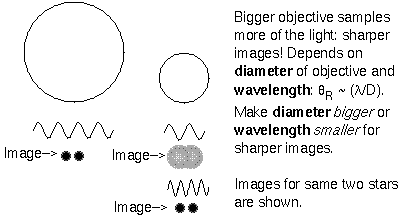
The desire is to make ![]() as small as possible. This can be done by making the observation wavelength
small (e.g., use UV instead of visible light) or by making the objective diameter
large. Another way to understand it is the more waves that can be packed on the
objective, the more information the telescope detects and, therefore, the more
detailed the image is. A 40-centimeter telescope has two times the resolution of
a 20-centimeter telescope at the same observing wavelength
(
as small as possible. This can be done by making the observation wavelength
small (e.g., use UV instead of visible light) or by making the objective diameter
large. Another way to understand it is the more waves that can be packed on the
objective, the more information the telescope detects and, therefore, the more
detailed the image is. A 40-centimeter telescope has two times the resolution of
a 20-centimeter telescope at the same observing wavelength
(![]() for the 40-centimeter
telescope is one-half the
for the 40-centimeter
telescope is one-half the
![]() for
the 20-centimeter telescope). However, fluctuations in the
atmosphere will
usually smear images into a fuzzy blob about one arc second or more across so the
resolution is usually limited to the resolution from a 12.5-centimeter telescope
on the ground. I will discuss the atmosphere's effect on images further in the
another section and ways you can compensate for it.
for
the 20-centimeter telescope). However, fluctuations in the
atmosphere will
usually smear images into a fuzzy blob about one arc second or more across so the
resolution is usually limited to the resolution from a 12.5-centimeter telescope
on the ground. I will discuss the atmosphere's effect on images further in the
another section and ways you can compensate for it.
The desire for greater resolving power is the main reason why radio telescopes are so enormous compared to their optical counterparts. Radio wavelengths are LARGE so the radio telescope must be LARGE to get decent resolving power (and also to increase the signal strength of the low-energy radio waves---light-gathering power!). The Keck 10-meter telescope is considered to be a very large optical telescope. However, it is easily dwarfed by the HUGE 305-meter Arecibo Radio Telescope at the Arecibo Observatory. A picture of this telescope is shown below. This telescope was built in a natural bowl-shaped valley in Puerto Rico. The telescope collapsed in 2020 and plans are still being made (at the time of writing) for its replacement. Clicking on the image will show the telescope from other perspectives. China built an even larger radio telescope within a natural basin in the southwester Guizhou province: the Five-hundred-meter Aperture Spherical Telescope (FAST). It began operation in September 2016.
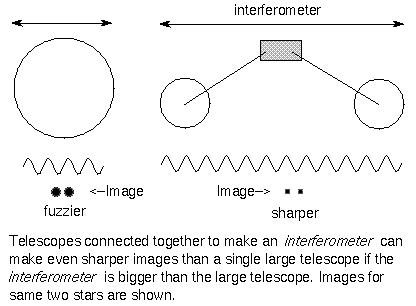
Another way to increase the resolution is to connect telescopes together to make an interferometer. Radio waves from an object reach each telescope in the interferometer at slightly different times, so the waves are out of sync with one another. Knowing the distances between the telescopes and how out of sync the waves are, the signals can be combined electronically to create an image of exceptional resolution. The image has the same sharpness as one taken by a single instrument that would extend from one end of the interferometer to the other. The light-gathering power is equal to the sum of the light-gathering powers of each individual telescope. To learn more about the principles of interferometry, see NASA/JPL's Origins Explorers cartoon.
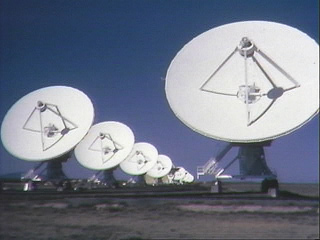 |
A spectacular example of such a system is the Very Large Array shown here. This telescope is made of 27 radio dishes, each 25 meters in diameter, on a Y-shaped track. Fully extended, the Very Large Array is 36 kilometers across and has a resolution of around one arc second (depending on the radio wavelength). It has the light-gathering power of a 130-meter telescope. Aerial views are shown below. Another example is the Australia Telescope Compact Array outside of Narrabri. Six 22-meter dishes can be placed in an array 6 kilometers across. A photo tour of the site is available here. |
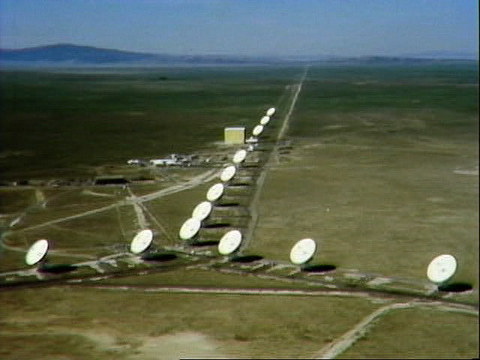 |
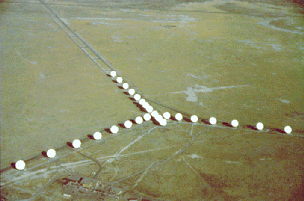 |
The Very Long Baseline Array is a huge interferometer that uses ten telescopes placed in sites from Hawaii to the Virgin Islands (see map below). This telescope is 8,600 kilometers across and has a resolution as good as 0.0002 arc second! With a resolution about 50 times better than the Hubble Space Telescope, it is able to detect features as small as the inner solar system at the center of our galaxy, about 27,000 light years away. A similarly-sized array of radio telescopes, called the Event Horizon Telescope, is being used to image the supermassive black holes at the centers of galaxies. Astronomers are constructing radio telescopes out in space that work in conjunction with ground-based radio telescopes to make interferometers much larger than the Earth (see also the Orbiting VLBI web site).
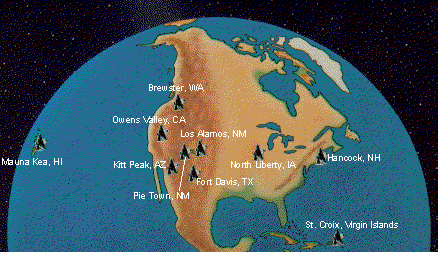
Sites for the Very Long Baseline Array---an array 8600 km across!
Other huge radio telescope arrays include Australian Square Kilometre Array Pathfinder (ASKAP) made of 36 identical antennae, each 12 meters in diameter, in western Australia; and the Atacama Large Millimeter/submillimeter Array (ALMA) at over 16,500 foot (5000 meters) elevation in the Atacama Desert in Chile. ALMA is made of 66 total antennae with 54 of them 12 meters in diameter and 12 of them 7 meters in diameter in an array 16 kilometers across. Both ALMA and ASKAP are large international projects.
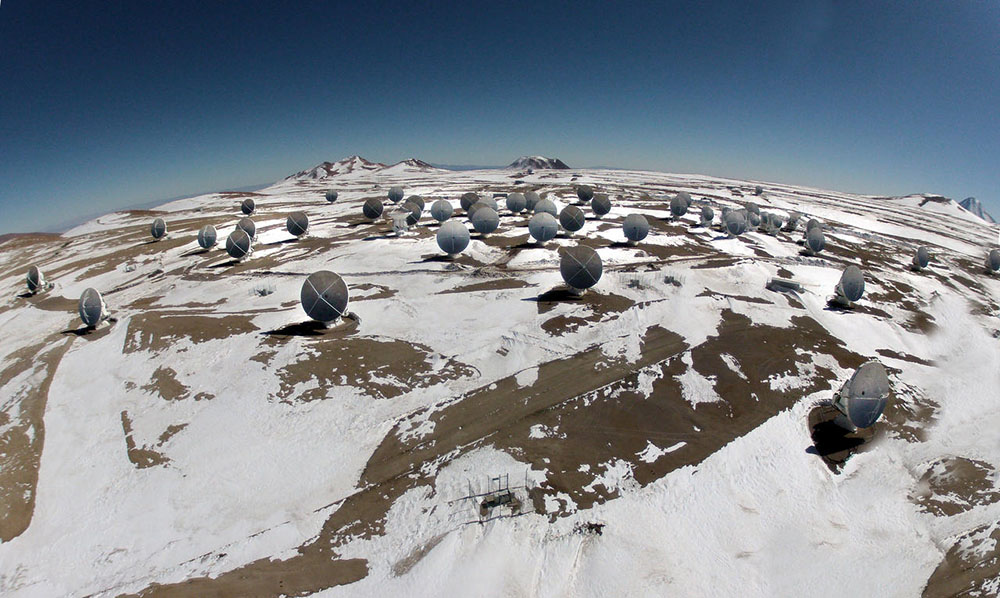
Central Cluster of antennae of the Atacama Large Millimeter/submillimeter Array (ALMA)
Astronomers are also now connecting optical telescopes to increase their resolving power. Two nice examples are the Large Binocular Telescope Interferometer on Mt Graham in Arizona (USA) and the Very Large Telescope Interferometer of Paranal Observatory on Cerro Paranal in the Atacama Desert, northern Chile.
![]() Go back to previous section --
Go back to previous section --
![]() Go to next section
Go to next section
last updated: January 20, 2022